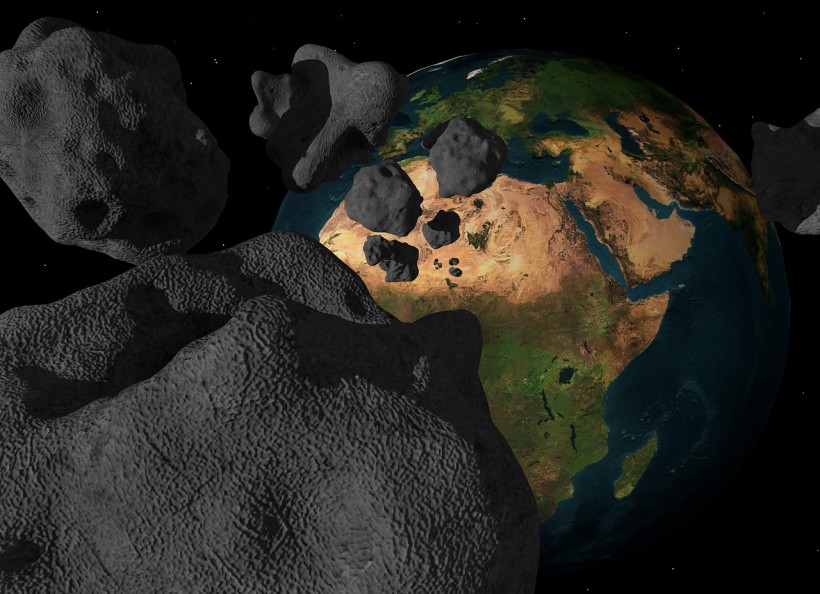There are currently over 30,000 near-Earth objects (NEOs) scientists identified and some are classified as "potentially hazardous." The designation is given to those asteroids approximately 460 feet (140 meters) in diameter that will orbit about 0.5 astronomical units (4.6 million miles) of Earth's path around the Sun
According to the UN Office for Outer Space Affairs, NEOs came from objects that have experienced gravitational disruptions from nearby planets, propelling them into orbits that allow them to approach Earth. Here are the largest "potentially hazardous" NEOs that will have a close flyby with Earth this 2023 based on the data from NASA's Center for Near Earth Object Studies (CNEOS) database as reported by Newsweek.

Largest 'Potentially Hazardous' Near-Earth Objects Predicted To Have a Close Flyby in 2023
Asteroid 363505 (2003 UC20)
This 1.2-mile (6,230-feet) asteroid will come close to Earth at 3.2 million miles (5.1 million kilometers) in November. It is more than twice as large as the Burj Khalifa and will have its next close approach on December 2032 when it is 7.6 million miles (12.37 million kilometers) from Earth, according to The Sky.org.
Asteroid 199145 (2005 YY128)
As per Space Reference, asteroid 199145 (2005 YY128) 199145 a small asteroid, measuring between 1,870 and 4,265 feet across, whose orbit crosses the orbit of Earth. NASA JPL has classified it as a "Potentially Hazardous Asteroid" due to its predicted close flybys with Earth. It is estimated to approach the planet on February 16 with a minimum distance of around 2.8 million miles.
Asteroid 436774 (2012 KY3)
As Newsweek reported, the CNEOS database indicates that the 436774 (2012 KY3) will come as close as 2.9 million miles (4.6 million kilometers) from Earth on April 13. The asteroid measures between 1,771 and 3,937 feet across or as long as the Navy Pier in Chicago.
Asteroid 139622 (2001 QQ142)
Asteroid 139622 (2001 QQ142) measures between 1,738 and 3,937 feet with an orbit that crosses the orbit of Earth, Space Reference reports. NASA JPL it as a "Potentially Hazardous Asteroid" due to its predicted close approach with Earth. The asteroid will have a close flyby to Earth on December 6 at a distance of 3.4 million miles (5.1 million kilometers).
Asteroid 349507 (2008 QY)
CNEOS database reveals that it measures between 1,706 to 3,937 feet across and will make its closest approach to Earth on October 3 at a distance of 3.9 million miles 6.2 million kilometers from the planet. Space Reference said that it has 16 close approaches in the coming decades.
Asteroid 2022 AE1 Predicted to hit Earth in 2023 Proven to Be Safe
Initial observations of asteroid 2022 AE1 revealed a potential Earth impact on July 4, 2023, according to the European Space Agency (ESA). That means there is not enough time to attempt deflection, and worse of all is that it is large enough to cause significant damage to a local area if it struck.
Based on the first seven days of observations, the likelihood of impact seemed to be growing, followed by a dramatic week 'in the dark' as the full Moon outshone the prospective impactor, shutting out further observations.
As the Moon moved away, the sky darkened, and the ESA's Near-Earth Object Coordination Centre (NEOCC) took another look, only to discover that the risk of collision was rapidly decreasing. Since then, it has been confirmed that 2022 AE1 will not collide with Earth and has been removed from the ESA's risk list.
RELATED ARTICLE: Defunct Arecibo Telescope Finds At Least 70 Potentially Hazardous Near-Earth Objects, Asteroids
Check out more news and information on Near-Earth Objects in Science Times.














